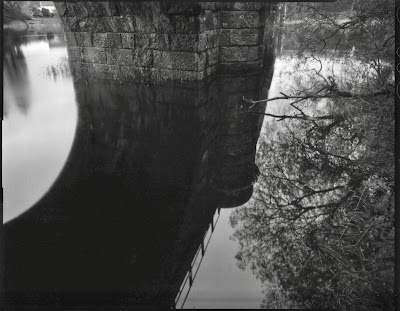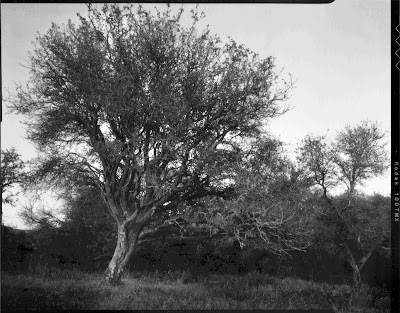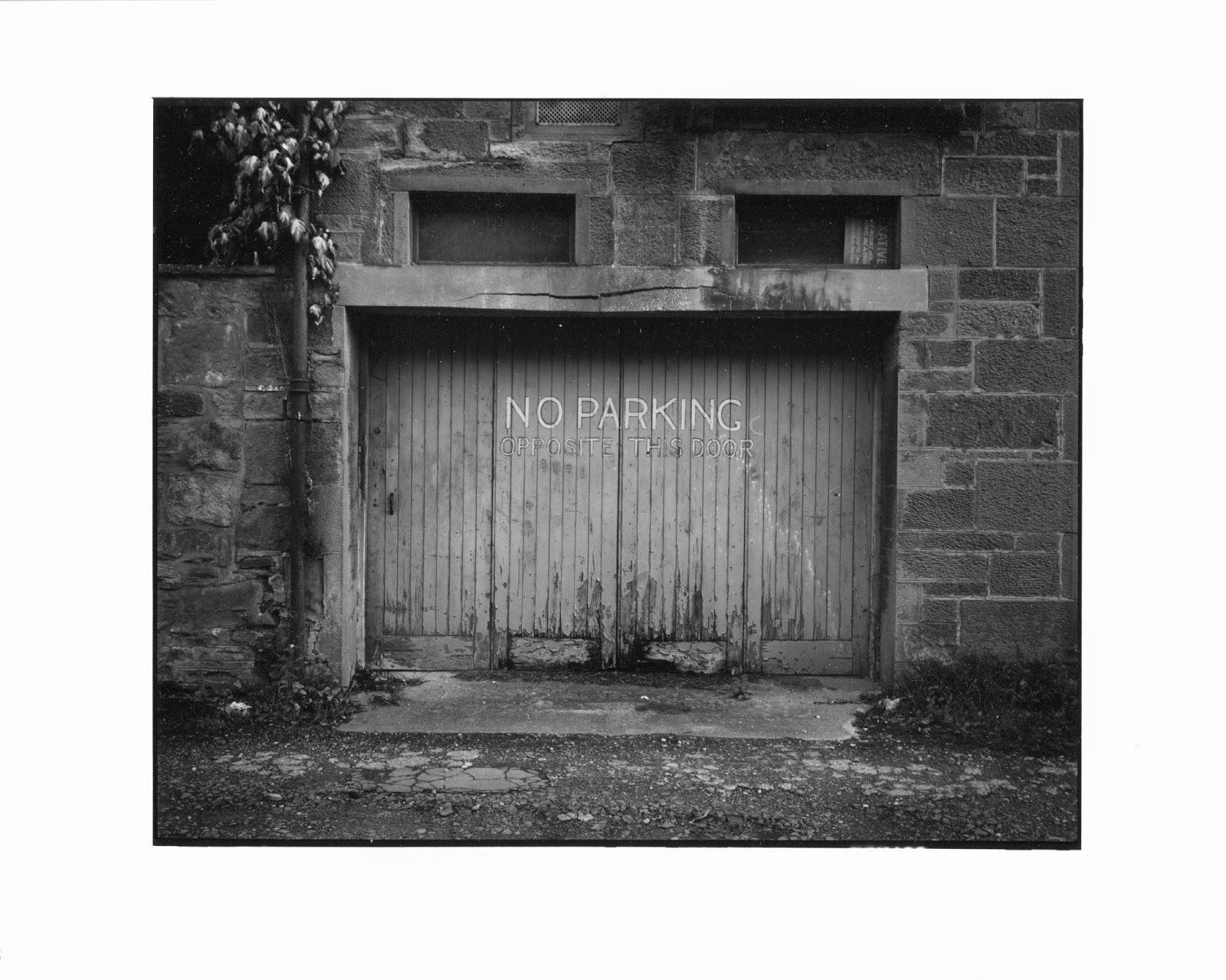OK - a slightly more serious tone than usual and about something you maybe know nothing about - I know I certainly didn't until it happened.
Life can be strange sometimes - after a break of approximately 5 years, I decided I really must trundle out the LF gear and start using some of the expired film I still have left before making an ultimate decision on what to do with all the gear that is clogging my study like a deep-fried pizza in the arteries of a 60 year old.
So there we were, eating our tea (coincidentally - home-made pizza) and literally like a bird crapping on your chips a cloud of black smoke appeared in front of my left eye.
At first I wasn't sure at all what it was - had someone set fire to the piece of pizza I was holding?
Why just one eye?
Had the dining table burst into flame?
Had I just expunged a rare and deadly black wind?
I looked sideways and the smoke followed.
Up.
Down.
Sides.
Periphery.
Every way I looked it followed.
I had by this point stopped eating and was trying to understand what was going on.
I'd also stopped talking, which my family knows meant something was up.
In truth I was shitting myself, not literally, but more along the lines of:
Oh FECK, am I having some sort of small stroke?
Everything felt alright. No droops or dribbles. All limbs functioning. To all intents and purposes everything was fine . . . except for the smoke.
The sun broke through and looking out of my periphery, the smoke took on the colour of deep black blood.
I panicked, left the room, followed by my wife and son, who were trying to work out what was going on.
I sat and explained, or at least tried to explain what the heck was going on.
I tried to calm myself down - there was no pain, but everywhere I looked the smoke followed.
I waited to see if anything else would happen.
I opened and closed my eyes a myriad of times; looked every which way; focused; de-focused and thought to myself if I didn't know better I would say it was like all the floaters I'd ever seen in my eyes coming to life at once and doing a lovely little smokey dance.
No pain though.
That was the thing that kept me going and stopped me battering around the house like a headless chicken.
To say I was severely worried though, would be an understatement.
My wife's advice was to remain calm and sit and see if anything else happened, which is exactly what I did.
And it didn't.
Sounds pretty scary doesn't it, well it felt like that too.
Everything remained fine that night and the next morning I phoned the doctors, who immediately said phone an optician, which I did.
Fortunately there is one quite close to us, so he asked me to come in for an inspection . . so there I was a few hours later, up on the ramps, mask on and some interesting optical toys to look at - Topcon!
I was glared at, blinded, flared and generally given a most thorough going-over, and was told that what I had had was a PVD and that it was very common (he was averaging around 3 a week) which surprised me, especially seeing as I'd never heard of it.
Here's a run-down on them:
Posterior Vitreous Detachment (PVD) is a natural change that occurs during adulthood, when the vitreous gel that fills the eye separates from the retina, the light-sensing nerve layer at the back of the eye
SYMPTOMS IN DETAIL
Mild floaters in the vision are normal, but a sudden increase in floaters is often the first symptom of PVD.
During PVD, floaters are often accompanied by flashes, which are most noticeable in dark surroundings. Most patients experience floaters and flashes during the first few weeks of a PVD, but in some cases the symptoms are hardly noticeable. if pvd is complicated by vitreous hemorrhage, retinal detachment, epiretinal membrane, or macular hole, the flashes and floaters may be accompanied by decreased or distorted vision. Floaters are most bothersome when near the center of vision and less annoying when they settle to the side of the vision. They may appear like cobwebs, dust, or a swarm of insects—or in the shape of a circle or oval, called a Weiss ring
Over time, the vitreous gel that fills the eye becomes liquid and condenses (shrinks) due to age and normal wear and tear. Eventually it cannot fill the whole volume of the eye’s vitreous cavity (which remains the same size during adulthood) and so the gel separates from the retina, located at the very back of the eye cavity.
Over the next 1 to 3 months, the vitreous gel further condenses and the sides of the gel also separate from the retina until the PVD is complete and the vitreous gel is attached to the retina only at the vitreous base (see Figure 1). Clear vitreous fluid fills the space between the condensed vitreous gel and the retina.
If a PVD progresses gently, gradually, and uniformly, the symptoms are typically mild. However, if the forces of separation are strong or concentrated in a particular part of the retina, or if there is an abnormal adhesion (sticking together) between the vitreous gel and the retina (such as lattice degeneration), the PVD can tear the retina or a retinal blood vessel.
Flashes and floaters are typically more obvious when PVD is complicated by a retinal tear or vitreous hemorrhage. These conditions can lead to further complications, such as retinal detachment or epiretinal membrane, which can result in permanent vision loss. However, about 85% of patients who experience PVD never develop complications and in most cases, the flashes and floaters subside within 3 months.
So where does that leave me a month down the line?
Well, it is testing - I think my right eye has had one too though to a lesser extent.
If you can imagine you're looking into sunlight using two early uncoated Cooke portrait lenses, you'll get the idea of how the world looks - soft and flarey in places, marvellously sharp in others, and it changes all the time.
I hope to goodness it does settle, because it can be testing at times, especially using a camera.
It's fine with anything that has a focus aid like a split prism, or else requires guess-work like the SWCM, but for something which requires heavy duty oggling like a 5x4 then it is nigh impossible.
I say impossible - if I had a mind to do it I am sure I could, but it would take even longer than usual and it always takes bloody ages anyway.
It's haunting me though.
What if it doesn't clear up?
I can't get past that question because it is a big one.
Bright sunshine can be problematic, and I dread to think how it'll be in Winter, especially driving on a wet dark night . . . if it stays like this I won't be driving and that means no more visits to the hills at that time of year (not that I do it much, but all the same).
Anyway, I'll keep you posted - I guess the whole point in writing this is that as a photographer your eye health is primo.
Look after your beady mincers!
On the subject of hauntings, not that I've captured anything spooky, but I think I might have captured some atmospheres.
They hadn't been obvious before, but maybe it is my blurry vision . . I dunno.
Anyway, as I was stirring into action about the Wista, I was looking at a bunch of contact prints from about 2014 and they sang to me.
Scouting around I also came across a couple of prints that seemed to have the same feel - see what you think.
The first two are scans off of prints.
The first was taken with the 16-On kit on the Rollei T.
The second was a Sinar with a mid-60's single coated 90mm Angulon - a lovely lens.
Everything after that is a mix of 90mm Super-Angulon and 127mm Ektar on the Wista DX - the scans are off 5x4 contact prints.
 |
| Pilgrim's Way |
 |
| Ghillie's Bridge (Broken) |
 |
| Railway Bridge Piers |
 |
| Time and Warer |
 |
| Grove and Spring |
 |
| Lone Tree |
 |
| Edge of Grove |
 |
| Twilight and a Weird Feeling |
 |
| Old Oak and Time |
And that's it really.
Be aware of your eyes and I hope it (or the worse things that can come from it) doesn't happen to you - it is a big worry, and typing this, this morning, through a light fog of mistiness I hope to goodness it clears soon.
It's taken me a while to get enthused about using 5x4 again and I've got around 75 sheets of film to use up before it turns back into oil!
Take care.

























